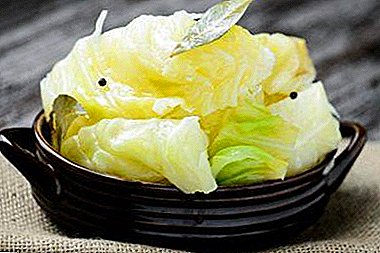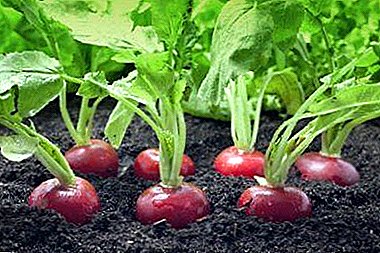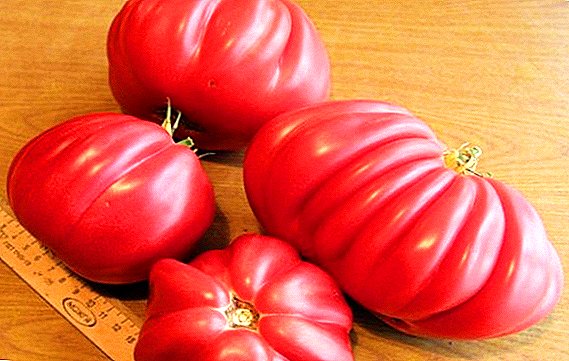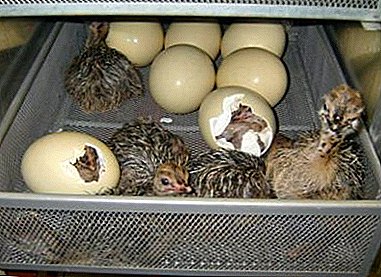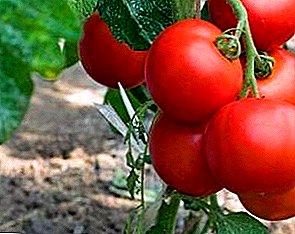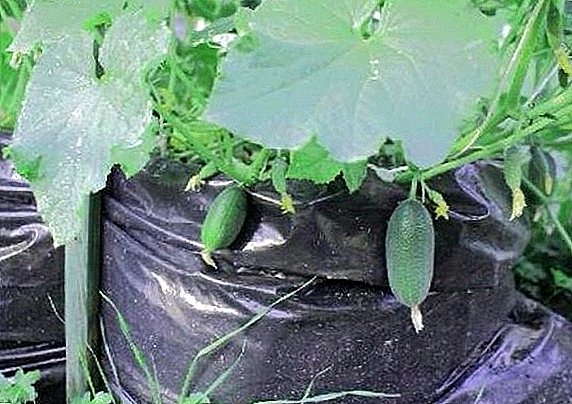 Many gardeners will be surprised to read about such an idea for planting cucumbers. However, the cultivation of cucumbers in bags is a great innovative approach that will not only save space on the beds, but also get a rich harvest of beautiful, tasty cucumbers. In this article you will learn how to plant cucumbers in bags, and the order of their cultivation step by step.
Many gardeners will be surprised to read about such an idea for planting cucumbers. However, the cultivation of cucumbers in bags is a great innovative approach that will not only save space on the beds, but also get a rich harvest of beautiful, tasty cucumbers. In this article you will learn how to plant cucumbers in bags, and the order of their cultivation step by step.
Pros and cons of the method
Planting cucumbers in bags has many advantages. The main ones include:
- high yield;
- saving space in the garden;
- the ability to grow vegetables on the balcony, loggia, in the gallery;
- saving effort on caring for plants;
- convenient to harvest;
- the fruits do not touch the ground, therefore they remain clean and do not rot.
If the room size allows, cucumbers can be planted in bags even in an apartment and grown all year round. The main thing is to create and maintain the necessary temperature, light and water conditions.
 However, when choosing such a method, it should be borne in mind that it has some drawbacks. These include:
However, when choosing such a method, it should be borne in mind that it has some drawbacks. These include:
- the difficulty of maintaining the desired level of humidity;
- in hot weather, high temperatures may form in the containers, causing the plant root system to die.
Important! To reduce the level of evaporation of moisture and heating of tanks, it is recommended to buy bags of white color.
Preparation of cucumber seeds
To grow strong plants and achieve a high level of yield, seeds need to be prepared before planting. This process goes through several stages:
- seed selection;
- warming up;
- treatment;
- hardening.
 Seeds for planting choose large and full. To select a good seed, you need to soak the seeds in water at room temperature for 5 minutes, then for 10-15 minutes, place in a solution of sodium chloride (50 g of salt per liter of water). Seeds that float, throw away - they are empty and unsuitable for planting. After this procedure, the seed must be dried. For this, the seeds are laid out on a shred of cloth and placed in the sun (beware of direct sunlight) or spread on a saucer and put on the battery.
Seeds for planting choose large and full. To select a good seed, you need to soak the seeds in water at room temperature for 5 minutes, then for 10-15 minutes, place in a solution of sodium chloride (50 g of salt per liter of water). Seeds that float, throw away - they are empty and unsuitable for planting. After this procedure, the seed must be dried. For this, the seeds are laid out on a shred of cloth and placed in the sun (beware of direct sunlight) or spread on a saucer and put on the battery.To cucumbers were resistant to fungal diseases and pests, seed need to be disinfected. To do this, the seeds are heated at a temperature of 60 ° C for about two hours. Warming up increases yield. Then the seeds are recommended to be placed for half an hour in a solution of potassium permanganate (10 g potassium permanganate per liter of water). For disinfection, you can use TMTD powders (2 g of the drug for 500 g of seeds) or Granozan (1.5 g of the drug for 500 g of seeds). Seeds are placed in a closed container, sprinkled with powder, then shake the container for about five minutes. After treatment, the seed is washed with water and dried.
Did you know? To improve the yield, some experts recommend that after disinfection place the seeds in a solution of wood ash. To prepare the solution, it is necessary to pour 2 tablespoons of ash with a liter of water and insist 48 hours. Seeds for a couple of hours are placed in the prepared mixture, and then dried. This procedure allows you to saturate the seed nutrients.
 In order for the plant to withstand temperature extremes well, it is recommended to harden the seeds. To do this, they are placed on a damp cloth and held there before they swell. If the material dries out, it should be slightly moistened. When several seeds turn, the seed is placed on the top shelf of the refrigerator for a day, then moved another day to the bottom shelf. After the procedure, the seeds can be planted.
In order for the plant to withstand temperature extremes well, it is recommended to harden the seeds. To do this, they are placed on a damp cloth and held there before they swell. If the material dries out, it should be slightly moistened. When several seeds turn, the seed is placed on the top shelf of the refrigerator for a day, then moved another day to the bottom shelf. After the procedure, the seeds can be planted.Preparatory work before landing
Before you put cucumbers in bags, you need to prepare the necessary material:
- bags;
- garter sticks;
- priming;
- tubes for drip irrigation.
Important! It is not recommended to use plastic and fabric bags. They will heat up strongly due to the high summer temperatures. The root system of cucumbers in such containers is very susceptible to rotting.
Best of all bags of cucumbers to choose white, with a capacity of at least 50 liters. Sugar and flour bags are good. Preparation of bags for planting is compulsory drying. Bags can also be treated with TMTD disinfecting powder. However, if the bags are new, you can do without fungicides.
 Sticks in the future will be needed for garters climbing plants. It is recommended to prepare them immediately, especially if the support is inserted directly into the bag. If you stick the stick afterwards, there is a risk of damage to the root system of cucumbers. The height of the support should be from one and a half to two meters. The stick can also be inserted into the ground next to the bags.
Sticks in the future will be needed for garters climbing plants. It is recommended to prepare them immediately, especially if the support is inserted directly into the bag. If you stick the stick afterwards, there is a risk of damage to the root system of cucumbers. The height of the support should be from one and a half to two meters. The stick can also be inserted into the ground next to the bags.
Then follows the preparation of the soil for the cultivation of cucumbers. The best soil - a mixture of land from the garden with peat and manure. This soil is well breathable and moisture, which contributes to good growth and fruiting cucumbers.
You can water the plants in the usual way, but gardeners who actively use the method of planting cucumbers in bags, recommend watering the plants by droplets. This greatly reduces the risk of root decay.
Did you know? When using drip irrigation, the first crop ripens several weeks earlier than usual. In addition, this method reduces the risk of plant fungal diseases and slows the growth of weeds.
 It is recommended at the very beginning to determine the location of the bags, so that later the containers are not dragged or injured by the plants. The bag is half filled with soil, then a stick support is placed in the middle. In the ground next to the stick, you must place the tube with holes for drip irrigation. After that, the ground is filled into the container, sprinkling it with wood ash on top (this deters aphids). To prevent the soil from spilling out, the edges of the bags are folded into sides, which can be sealed with tape.
It is recommended at the very beginning to determine the location of the bags, so that later the containers are not dragged or injured by the plants. The bag is half filled with soil, then a stick support is placed in the middle. In the ground next to the stick, you must place the tube with holes for drip irrigation. After that, the ground is filled into the container, sprinkling it with wood ash on top (this deters aphids). To prevent the soil from spilling out, the edges of the bags are folded into sides, which can be sealed with tape.
Important! It is recommended to lay a layer of hay or sawdust on the bottom of the bag. This will improve the greenhouse effect, which will provide an early rich harvest.
It is better to arrange ready bags close to each other, so it will be more convenient to tie up. In addition, costs are saved on pipes for drip irrigation.
Sowing Cucumber Seeds
Sowing material is carried out in mid-May, when the air temperature reaches at least 15 ° C. If you are interested in how compactly to plant cucumbers, then the seeds should be sown not only from above, but also on the sides. On the top layer of planted no more than four pieces. The incisions on the side carried out evenly at a distance of 7-10 cm from each other. In one notch is placed no more than two small seeds, or one large. To preserve moisture, it is better to cover the top of the bag with foil.
Care for cucumbers in bags
Planting cucumbers and caring for them in bags does not require much effort. The most important point when using this method is the correct watering. With this growing vegetables it is difficult to withstand the necessary water regime. Like any other plants, cucumbers in bags need a garter. The garter not only serves to support the climbing stems, but also allows you to form even vertical rows, which will greatly facilitate the harvest.
Watering features
Cucumbers need moist soil. Watering should be regular. The most optimal time for its implementation is after five or six in the evening. The plants will also benefit from periodic water spraying of the foliage.
Did you know? To make the fruits better tied, experienced gardeners at the beginning of flowering slightly reduce the amount of watering cucumbers. After the plants start to wither, abundant watering is resumed.
 The best way to water is drip - through the tubes. This method will allow cucumbers to create an optimal amount of moisture for growth and fruiting, as well as prevent rotting of the root system. When watering plants with a hose or a bucket, you must be carefully monitored so as not to overwet the soil. On the surface it may be dryish, and inside - wet.
The best way to water is drip - through the tubes. This method will allow cucumbers to create an optimal amount of moisture for growth and fruiting, as well as prevent rotting of the root system. When watering plants with a hose or a bucket, you must be carefully monitored so as not to overwet the soil. On the surface it may be dryish, and inside - wet.
Fertilization
Feed cucumbers with organic and mineral fertilizers. Among organic, chicken manure, nettle extract, honey solution are very popular. They fertilize the soil when the first shoots appear, and then once a month after watering.
Important! Feed solutions should not be concentrated so that the root system does not get burned.
Among the mineral fertilizers, cucumbers are suitable superphosphates, potash salt. The dosage must clearly comply with the instructions, otherwise the plants can be harmed. Mineral fertilizers are applied to the soil about three times during the summer period. For the first time they fertilize when well-formed sprouts with several pairs of true leaves appear from the soil.
Formation of the bush and garter to the support
After the sprouts grow by 20-25 cm and five true leaves appear on them, it is necessary to make a plant garter. There are two types of garter cucumbers: vertical and horizontal.
 With a vertical garter, a two-meter support is installed near each bush, and the plant is tied to a stick with ropes. The knot is fixed between the second and third leaf. Then the rope is slightly tensioned and tied to a support. Thus, each bush will have its support. This method will take more time and effort than a horizontal garter. However, it is more reliable, and also simplifies the further care of plants.
With a vertical garter, a two-meter support is installed near each bush, and the plant is tied to a stick with ropes. The knot is fixed between the second and third leaf. Then the rope is slightly tensioned and tied to a support. Thus, each bush will have its support. This method will take more time and effort than a horizontal garter. However, it is more reliable, and also simplifies the further care of plants.
Important! The knot that is carried on the germ should not be too tight. The plants will grow and their stems will become somewhat thicker. Therefore, a tight knot can damage the cucumbers or else will impede their growth.
In case of a horizontal garter, wooden or metal supports are placed on both opposite sides of the row, between which two rows of wires or strong threads are tied. In the future, the sprouts will be tied to these threads. This method is simpler than the previous one, however it has many drawbacks:
- over time, the threads begin to sag;
- it is difficult to equally calculate the tension force when each new bush is tied up;
- reaching the first row, cucumbers will curl along it, not wanting to grow further upwards.
Most of the traditional varieties and hybrids of cucumbers form fertile female flowers on lateral stems, while male flowers grow on the main shoots - barren flowers. Therefore, before the formation of bushes it is necessary to carry out pinching. This will provide an opportunity to get more lateral stems and harvest. The process consists of pinching off the top of the central stem after the sixth leaf.
After pinching, side shoots should be tied to a stick so that they do not shade the ovary of each other and do not interfere with the formation, growth of fruits. In this case, several side shoots are left to form a bush. This will increase the amount of the crop. The process of the formation of bushes takes place in such stages:
- central stem tied to a support;
- after the appearance of the first ovaries on the lateral stems, the shoots are tied to the central stem with the help of its whiskers.

Important! Try to maintain a distance of not less than 70 degrees between the main stem and the lateral ones so that the shoots are not damaged.
Such a mustache garter during the growth of the plant will need to be carried out several more times. Also, do not forget to regularly remove all yellow or damaged leaves.
Some Tricks for a Great Harvest
Care for cucumbers in bags is simple. To get more harvest, there are some secrets:
- do not thicken the planting, in one bag with a capacity of 50 l should not be planted more than 15 seeds;
- pinch central shoots to increase the number of side, which develop fertile female flowers;
- periodically remove the lower leaves that form below the ovary so that they do not shade the flowers and do not interfere with their pollination;
- a couple of times a month, it is recommended to spray the cucumbers with honey solution for better flowering and pollination of plants (a teaspoon of honey per liter of water);
- harvest in time;
- fertilizing plants with superphosphates and potash fertilizers will help improve yields.
Did you know? Cucumbers love milk. Twice a month feeding the plants with a solution of milk (1: 2) can accelerate their growth and increase their yield.
Harvesting
 Cucumbers in bags bear fruit faster than those planted in open ground. Therefore, their collection should be carried out more often. Harvest should be carefully, holding the stems with one hand, so as not to damage the plant. It is best to carry out the process in the evening - after five to six hours. Cucumbers that you want to grow on seeds should be left on the stems until the fruit turns yellow.
Cucumbers in bags bear fruit faster than those planted in open ground. Therefore, their collection should be carried out more often. Harvest should be carefully, holding the stems with one hand, so as not to damage the plant. It is best to carry out the process in the evening - after five to six hours. Cucumbers that you want to grow on seeds should be left on the stems until the fruit turns yellow.
Grow cucumbers in bags is not difficult. The most important point in the care is compliance with the irrigation regime. Pinching and the formation of bushes will significantly increase the amount of harvest.


